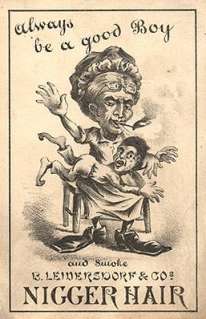Bigger Hair

Bigger Hair Smoking Tobacco, formerly known as Nigger Hair Smoking Tobacco, was a tobacco brand manufactured by the B. Leidersdorf Company. It was first produced in 1878 but is no longer manufactured.[1]
History
Nigger Hair Smoking Tobacco was first manufactured by the Milwaukee, Wisconsin-based B. Leidersdorf Company in 1878.[2] According to the company the product was named after "its distinctive, curly Long Cut strands".[3] The product was sold at economic prices and packaged in metal tins with "the head of a negro surmounted with a copious crop of wool, and having a large ring pending from the nose and another from the ear" stamped on the front.[4] Early advertisements for Nigger Hair bore the tagline "Always be a good boy and smoke B. Leidersdorf and Co.'s Nigger Hair".[5] In 1917, tickets for tradeable Nigger Hair Smoking Tobacco were commissioned by the American Tobacco Company. The production company changed the product's name to "Bigger Hair"[2] in the 1950s, following fierce criticism from the National Association for the Advancement of Colored People (NAACP).[6] The product was sold predominantly in North America. Today, its tins remain a prominent collector's item and can be found at various auctions.[1]
Trademark infringement
Leidersdorf filed a civil lawsuit in 1879 against a rival tobacco merchant by the surname of Flint who sold the Big Indian brand of Tobacco. Leidersdorf argued that Flint had infringed Nigger Hair's trademark. After discussion the judges ruled in Leidersdorf's favor and concluded that the two logos were not distinct enough to avoid confusing consumers.[4]
References
- 1 2 Terry O. Mike Tennant (January 2011). The Age of Persuasion (Large Print 16pt). ReadHowYouWant.com. pp. 308-. ISBN 978-1-4596-0935-8.
- 1 2 Debra L. Merskin (2011). Media, Minorities, and Meaning: A Critical Introduction. Peter Lang. pp. 265–. ISBN 978-1-4331-1140-2.
- ↑ "Nigger Hair Tobacco Keeps Him Happy". The Milwaukee Journal. April 21, 1914. pp. 12-.
- 1 2 Rosemary J. Coombe (13 October 1998). The Cultural Life of Intellectual Properties: Authorship, Appropriation, and the Law. Duke University Press. pp. 176–. ISBN 978-0-8223-2119-4.
- ↑ Temple Law Review. Temple University School of Law. 2003. pp. 172-.
- ↑ Sonia Maasik; J. Fisher Solomon (2006). Signs of Life in the U.S.A.: Readings on Popular Culture for Writers. Macmillan. pp. 559–. ISBN 978-0-312-43133-4.